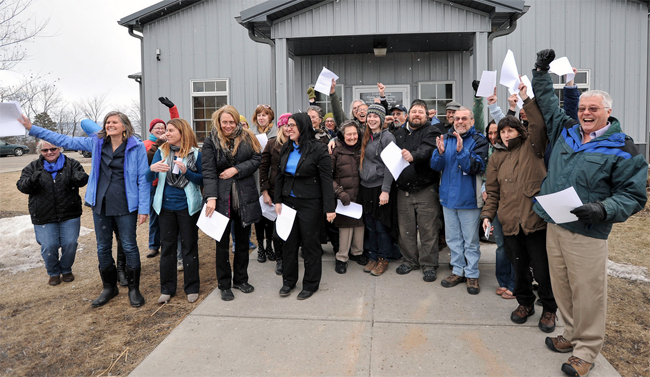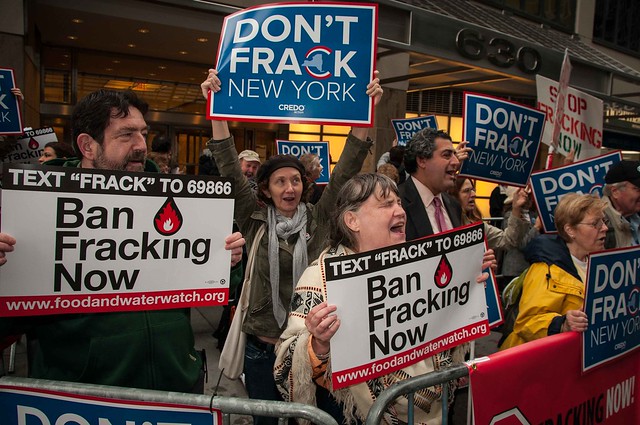FOR IMMEDIATE RELEASE—August 4, 2015
Media Contact: Sandra Steingraber | 607.351.0719
photos: http://www.wearesenecalake.com/encyclical-iv/
video: http://www.wearesenecalake.com/video/
13 Arrested While Reading Pope’s Encyclical on Climate Change in Blockade at Crestwood
Action Against Gas Storage at Seneca Lake Comes One Day After President Obama Releases Clean Power Plan
Watkins Glen, NY – Early this morning, in a peaceful act of civil disobedience action against gas storage in Seneca Lake salt caverns that took place the day after President Obama and the EPA announced the Clean Power Plan to move the nation away from fossil fuels, thirteen people from six New York counties were arrested while reading verses from Pope Francis’ recent encyclical letter on climate change.
Just after dawn, the 13 formed a human blockade at the north and south entrances of Crestwood Midstream’s gas storage facility on Route 14, preventing all traffic from entering or leaving, and began their reading. Joining the pontifical read-aloud was the Reverend John D. Elder, former pastor of the historic First Church in Oberlin, Ohio, and present part-time resident of Schuyler County. Rev. Elder was not arrested.
The words on the banners carried by today’s protesters—“Love the Common Good,” “And Care for This World”—were lines from the prayer that closes the encyclical.
Large trucks attempting to leave the facility were blocked at both the north and south gates of the Crestwood property shortly after 7 a.m. Schuyler County deputies arrested the blockaders at about 7:30 a.m. The 13 were taken into custody, charged with both trespassing and disorderly conduct, and released. None of the 13 blockaders this morning had been previously arrested as part of the We Are Seneca Lake movement, which opposes Crestwood’s plans for methane and LPG storage in lakeside salt caverns.
Two other individuals photographing and videotaping the event were inadvertently arrested and charged with trespassing.
Dan Taylor, 64, of Oxford in Chenango County said, “Yesterday, President Obama released the Clean Power Plan and put the nation on the path to renewable energy. Today, we are standing at the gates of dirty energy to say that Crestwood’s plan for the Finger Lakes is not a clean power plan. I am here to help impede the build-out of fossil fuel infrastructure.”
This morning’s recitation continued the read-aloud from the Pontifical document, Laudato Si! On Care for Our Common Home, that began during a blockade on June 30 and that continued during blockades on July 7 and July 20. All together, 44 people have been arrested as part of encyclical-themed blockades at Crestwood.
One of today’s arrestees, Faith Muirhead, 45, of Beaver Dams in Steuben County, grew up in the Town of Reading near the salt caverns. She said, “We are all of us stewards of the earth. I am a native of Reading and know that this area and Seneca Lake are gifts to be cherished and protected. I feel a responsibility to do what I can to protect these waters and this land. So I pray, I walk, I send letters, I call my state representatives, and today, I stand at the gates of Crestwood to demonstrate my resolve. I am a teacher, and a teacher of teachers. Today, I teach by putting my freedom in jeopardy in order to bring attention to the potential risks inherent in Crestwood’s plans.”
The total number of civil disobedience arrests in the eight-month-old campaign against gas storage now stands at 332.
Crestwood’s methane gas storage expansion project was approved by the Federal Energy Regulatory Commission last October in the face of broad public opposition and unresolved questions about geological instabilities, fault lines, and possible salinization of Seneca Lake, which serves as a source of drinking water for 100,000 people.
The 13 blockaders arrested today were:
George Adams, 65, Ithaca, Tompkins County
Pat Buttolph, 69, Elmira, Chemung County
Joshua Enderle, 20, Cuba, Allegany County
Ruth Groff, 63, Ithaca, Tompkins County
Mary Kirkpatrick, Ithaca, Tompkins County
Richard Hoyt, 64, Geneva, Ontario County
Susanne McNally, 70, Geneva, Ontario County
Faith Muirhead, 45, Beaver Dams, Steuben County
Patricia Rodriguez, 46, Brooktondale, Tompkins County
Trellan Smith, 49, Oxford, Chenango County
Dan Taylor, 64, Oxford, Chenango County
Lynn Westmoreland, 62, Naples, Ontario County
Robyn Wishna, 56, Slaterville Springs, Tompkins County
Read more about the protesters at: http://www.wearesenecalake.com/seneca-lake-defendes/.
Read more about widespread objections to Crestwood’s gas storage plans: http://www.nytimes.com/2014/12/26/nyregion/new-york-winemakers-fight-gas-storage-plan-near-seneca-lake.html?_r=1
Read Gannett’s investigative report about the risks and dangers of LPG gas storage: http://www.democratandchronicle.com/story/news/local/watchdog/2015/06/26/seneca-gas-storage-debated/29272421/.
Background on the protests:
Protesters have been blocking the Crestwood gas storage facility gates since Thursday, October 23rd, including a rally with more than 200 people on Friday, October 24th. On Wednesday, October 29, Crestwood called the police and the first 10 protesters were arrested. More information and pictures of the actions are available at http://www.wearesenecalake.com.
The unified We Are Seneca Lake protests started on October 23rd because Friday, October 24th marked the day that major new construction on the gas storage facility was authorized to begin. The ongoing acts of civil disobedience come after the community pursued every possible avenue to stop the project and after being thwarted by an unacceptable process and denial of science. The protests are taking place at the gates of the Crestwood compressor station site on the shore of Seneca Lake, the largest of New York’s Finger Lakes.
The methane gas storage expansion project is advancing in the face of broad public opposition and unresolved questions about geological instabilities, fault lines, and possible salinization of the lake, which serves as a source of drinking water for 100,000 people. Crestwood has indicated that it intends to make Seneca Lake the gas storage and transportation hub for the northeast, as part of the gas industry’s planned expansion of infrastructure across the region.
*Note that the WE ARE SENECA LAKE protest is to stop the expansion of methane gas storage, a separate project from Crestwood’s proposed Liquefied Petroleum Gas (LPG) storage project, which is on hold pending a Department of Environmental Conservation Issues Conference on February 12th.
As they have for a long time, the protesters are continuing to call on President Obama, U.S. Senators Schumer and Gillibrand, Governor Cuomo, and Congressman Reed to intervene on behalf of the community and halt the dangerous project. In spite of overwhelming opposition, grave geological and public health concerns, Crestwood has federal approval to move forward with plans to store highly pressurized, explosive gas in abandoned salt caverns on the west side of Seneca Lake. While the New York State Department of Environmental Conservation (DEC) has temporarily halted plans to stockpile propane and butane (LPG) in nearby caverns—out of ongoing concerns for safety, health, and the environment—Crestwood is actively constructing infrastructure for the storage of two billion cubic feet of methane (natural gas), with the blessing of the Federal Energy Regulatory Commission (FERC).
More background, including about the broad extent of the opposition from hundreds of wineries and more than a dozen local municipalities, is available on the We Are Seneca Lake website at http://www.wearesenecalake.com/press-kit-archive/.

 Photo by
Photo by 
